Explore Frauenkirche In Dresden Which Is A Renowned Architectural Masterpiece
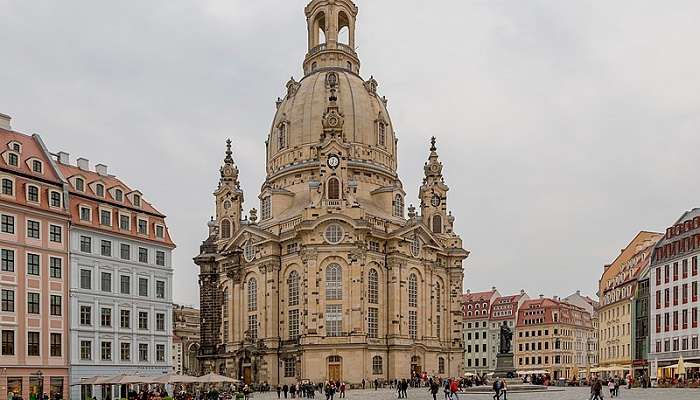
The Frauenkirche, or Church of Our Lady, is an iconic landmark in the historic city of Dresden, Germany. Destroyed during World War II, the church’s dramatic reconstruction and restoration have become a symbol of the city’s resilience. Rising majestically with its characteristic stone dome, the Frauenkirche in Dresden stands as a testament to the skill of its 18th-century architects and the determination of the German people. Today, this breathtaking Baroque masterpiece draws visitors from around the world, who come to marvel at its stunning interior and learn about its remarkable history.
About Frauenkirche In Dresden
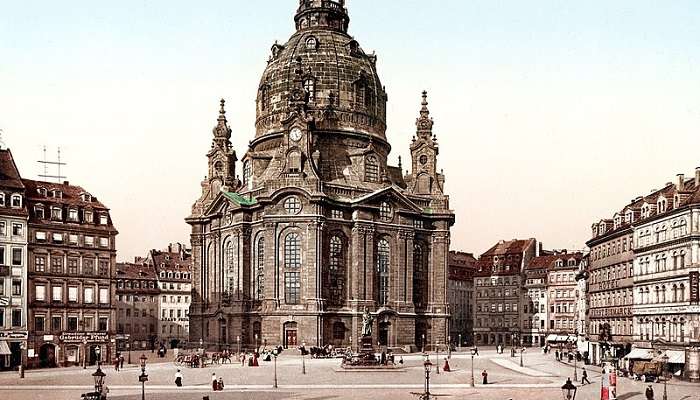
The Frauenkirche is a Lutheran church that was founded in Dresden, the state capital of Saxony in Germany. This beautiful building has been pulled down and rebuilt several times throughout history. It was first used as a Catholic church and was later on turned into a protestant church during the Reformation era. The 18th century saw it replaced by a large Baroque structure, one of the largest domes in Europe at that time. The church was heavily damaged during the Allied firebombing of Dresden in 1945, leaving behind only ruins for nearly 50 years, which served as a sombre war memorial. Following the reunification of Germany plans for reconstruction began in 1994, culminating in the church’s reconsecration on October 30, 2005.
Today, the Frauenkirche in Dresden symbolises the unity and the strength of the spirit of the people of Dresden who visit the church for both worship and tourism. It is sometimes erroneously referred to as a cathedral, but it is not the cathedral church of a bishop; that status belongs to the Church of the Cross, the state church of the Evangelical-Lutheran Church of Saxony. Also, there is a monthly Anglican Evensong at the church, which is an interdenominational worship service.
Also Read: Haunted Places In Munich
History Of Frauenkirche In Dresden
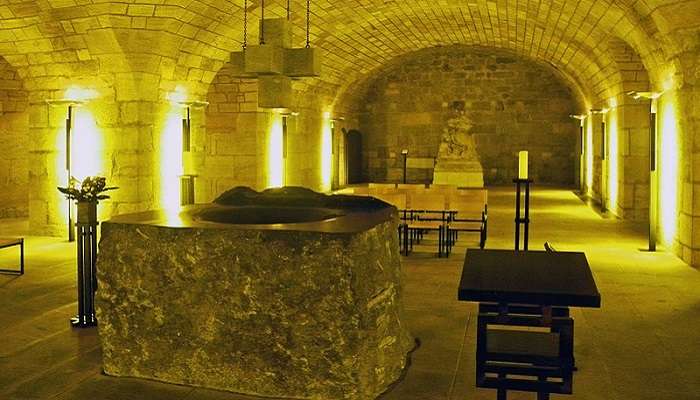
The Frauenkirche in Dresden has a rich and intricate history. Originally built in the 11th century as a Romanesque church dedicated to ‘Our Lady’ (Kirche zu unser Liebfrauen), it was located outside the city walls and surrounded by a graveyard. This early church served as the seat of an archpriest in the Meissen Diocese until the Reformation when it became a Protestant church. In 1727, the original structure was demolished to make way for a larger Baroque-style church designed by Dresden’s city architect, George Bähr. Construction began in 1726 and was completed in 1743, although Bähr did not live to see its completion. His design featured a central altar, pulpit, and baptismal font, reflecting the new Protestant liturgy.
A standout feature of the Frauenkirche is its high dome, known as the “Stone Bell” (die Steinerne Glocke). Standing at 67 metres (220 ft) and weighing 12,000 tons, this sandstone dome was an engineering marvel, comparable to Michelangelo’s dome in St. Peter’s Basilica. Despite initial doubts, it proved resilient, surviving over 100 cannonballs during the Seven Years’ War in 1760. The church also housed a remarkable organ built by Gottfried Silbermann, which Johann Sebastian Bach played at its dedication. For over 200 years, the Frauenkirche’s dome dominated Dresden’s skyline, becoming a symbol of the city’s architectural and cultural heritage. It even served as a refuge during the May Uprising in 1849. Notable burials include Heinrich Schütz and George Bähr, further solidifying its historical significance.
Destruction And Reconstruction Of Frauenkirche In Dresden
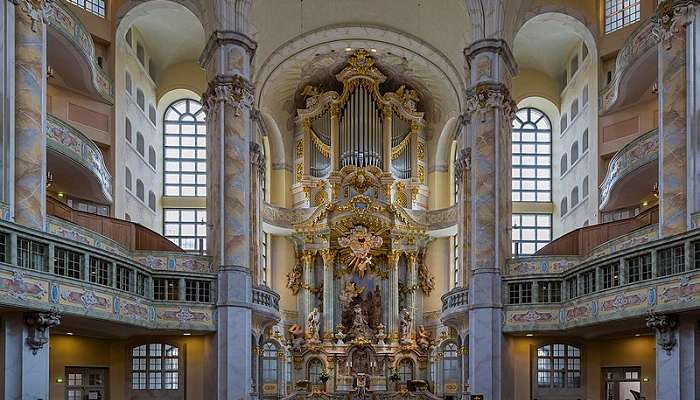
On February 13, 1945, Allied forces began the bombing of Dresden, leading to the Frauenkirche’s devastating destruction. The church withstood two days of relentless attacks, allowing around 300 people sheltering in its crypt to evacuate before succumbing to the extreme heat from approximately 650,000 incendiary bombs. By 10 am on February 15, the dome collapsed, causing the sandstone pillars to explode and nearly 6,000 tons of stone to crash to the ground. In the aftermath, the Frauenkirche in Dresden lay in ruins for 45 years, serving as a war memorial under East German Communist rule. Local citizens salvaged stone fragments for potential future reconstruction, and in 1966, the ruins were officially designated as a “memorial against war.” Following German reunification, reconstruction efforts began in 1992 using the original plans by architect George Bähr.
The foundation stone was laid in 1994, and the exterior was completed in 2004, with the church reconsecrated on October 30, 2005. Over 8,500 original stones were salvaged, and modern technology aided in the reconstruction process, ensuring historical accuracy. Frauenkirche in Dresden now stands as a symbol of hope and reconciliation, featuring a new organ and restored art, including a bronze statue of Martin Luther.
Related Post: Museums In Munich
Architecture Of Frauenkirche In Dresden

The Frauenkirche in Dresden is a stunning example of Baroque architecture, originally designed by George Bähr in the 18th century. The church features a centralised structure with an octagonal outline and a square floor plan, complemented by an east-facing choir apse. Its most striking feature is the soaring bell-shaped dome, made entirely of sandstone, which weighs over 12,000 tons and is considered the largest stone dome north of the Alps.
The dome is topped by a lantern that houses a viewing platform, offering panoramic views of Dresden. The exterior of the Frauenkirche is characterised by a mix of old and new stones, symbolising the reconciliation and healing of past wounds. The large windows and elegantly curved dome give the structure a light and porous appearance despite its massive stone facade. The church’s reconstruction, completed in 2005, faithfully restored its original design, making it a symbol of both architectural brilliance and historical resilience.
Things To See At Frauenkirche In Dresden
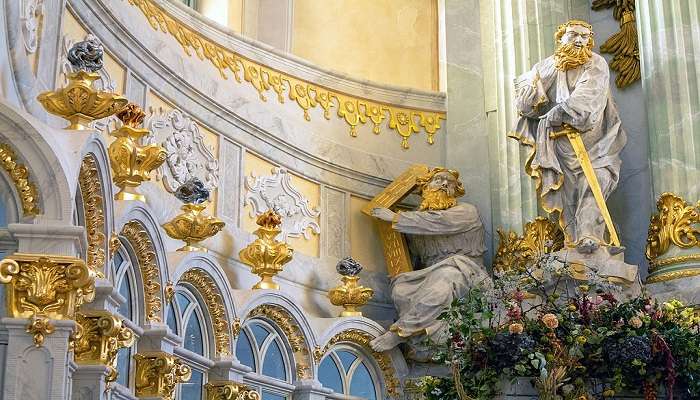
The Frauenkirche in Dresden is a magnificent Baroque church that symbolises reconciliation and resilience. Reconstructed after its destruction in World War II, it stands as one of Dresden’s most iconic landmarks. Below are the things to see at Frauenkirche:
Guided Tour of the Dresden Frauenkirche: This guided tour delves into the history, architecture, and design of the Frauenkirche. Discover its reconstruction journey and the importance of this iconic landmark.
Dresden City and Frauenkirche Private Walk: Take a private walking tour of Dresden, including a visit to the Frauenkirche. Uncover the city’s rich history and cultural heritage with an expert guide.
Concert at the Dresden Frauenkirche: Attend one of the numerous concerts held at the Frauenkirche. The church hosts over 100 events annually, featuring a diverse range of classical music performances.
Art Exhibition at the Dresden Frauenkirche: Explore the exhibition in the Frauenkirche’s basement. It highlights the church’s destruction during World War II and its subsequent reconstruction, as well as the donors and supporters who made the rebuilding possible.
Participation in Religious Services: Participate in Sunday services, daily devotions, or special events like weddings and baptisms. The Frauenkirche is an open church, welcoming everyone to join its spiritual life.
Related Post: Munich Lakes
Opening Hours, Entrance Fees, And Best Time To Visit
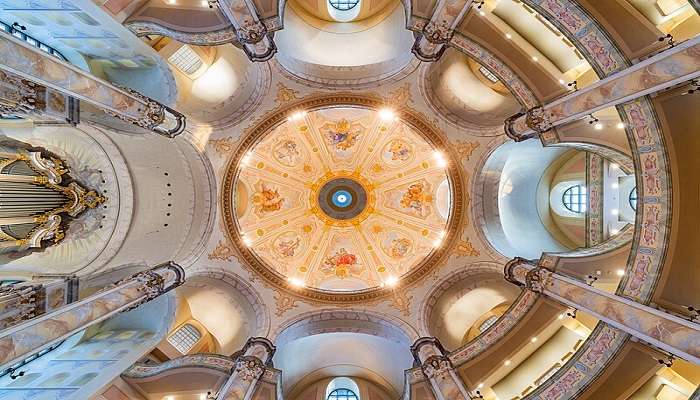
The Frauenkirche in Dresden is open to the public during the week with the following timetable: Monday to Friday – 10:00 AM – 11:30 AM and 1:00 PM – 5:30 PM. As for the working hours, it is better to check the schedule as it may be different during the weekends. The church is accessible to the public during these times, and there are no fees to pay to get in. However, the public is urged to support the conservation of this historical structure in any way they can.
One should consider visiting the Frauenkirche in Dresden in the spring or summer months, from April to June. This season is relatively moderate with regard to weather, and the various activities held in the city make the experience even more exciting, such as festivals and other events. However, Frauenkirche draws visitors’ attention all year round, and it is one of the most interesting places to visit in Munich.
How To Reach?

It is easy to get to Frauenkirche in Dresden since there are several ways of transport that one can use. Below are detailed descriptions of how to get this iconic church by air, rail, and bus:
By Air
If you are planning to travel to Frauenkirche in Dresden by air, then Dresden International Airport (DRS) is the nearest airport. Once at the airport, there are several ways to get into the city centre. Another way is to take a taxi, which will take approximately 20 minutes. However, there is the airport shuttle service that will take you directly to central Dresden if you do not want to take a taxi. There is also public transport, such as the S-Bahn (S2), which will lead to Dresden Hauptbahnhof, the main railway station from where Frauenkirche can be accessed either on foot or by tram.
By Rail
If you prefer travelling by rail, you could come by Dresden Hauptbahnhof, the main railway station. From there, you can walk to Frauenkirche, which is about twenty minutes walk away or take a tram. Several tram lines, including tram numbers 3, 7, and 8, will take you to places like Pirnaischer Platz or Altmarkt, which are near Frauenkirche.
By Bus
Those who intend to move around Dresden by bus are allowed to use the city transport system. The closest tram stations to Frauenkirche are Pirnaischer Platz or Altmarkt, tram lines 1, 2, 3, 4, 7, and 12. If you wish to take a bus, then the nearest bus stop to the church is Pirnaischer Platz, and buses numbers 62 and 75 will take you to the church.
You May Also Like To Read: Hindu Temples In Germany
The Frauenkirche in Dresden is one of the examples of how this city has risen from the ashes and come back to life. Its beautiful baroque architecture, which was once in a state of decay, is today attracting tourists from across the globe. From the dome of the Frauenkirche to the carvings on its interior, the Frauenkirche is a symbol of Dresden. If you have been moved by the beauty and history of the Frauenkirche, then why not visit Germany and see it for yourself? Discover the history, the architecture, and the people of Germany and learn why this country is a perfect place to visit. Don’t delay. Book your trip to Germany now to find out what this beautiful country has to offer you.
For our editorial codes of conduct and copyright disclaimer, please click here.
Cover Image Credit : Uwe Aranas for Wikipedia
Frequently Asked Questions About Frauenkirche In Dresden
What are some interesting facts about the Frauenkirche?
The Frauenkirche in Dresden was reconstructed using 8,425 original stones after being destroyed during WWII. Its dome, famously called the Stone Bell, is an outstanding example of Baroque architecture and stands as a testament to meticulous restoration efforts.
What is the significance of the Frauenkirche Dresden?
The Frauenkirche symbolises reconciliation between former enemies after WWII. Its reconstruction serves as a symbol of Dresden's resilience and dedication to Lutheranism while also commemorating the city's journey toward healing and peace.
Why is Frauenkirche Famous?
The Frauenkirche is renowned for its exquisite Baroque architecture, historical importance as a symbol of reconciliation post-WWII, and status as a key landmark in Dresden, drawing visitors for both its beauty and its story of rebirth.
Who is Buried in Frauenkirche?
The Frauenkirche in Munich houses the tomb of Holy Roman Emperor Louis IV, along with several members of the noble Wittelsbach family, making it an important burial site for Bavarian royalty and a significant location in Munich's history.
How Old is Frauenkirche?
The Frauenkirche in Munich was completed in 1488 and consecrated in 1494, making it over 530 years old. This Gothic-style cathedral remains one of the city's most important historical and architectural landmarks.
People Also Read:
Churches In Switzerland Churches In Mexico Churches In Ottawa

Unveil the hidden treasures of the globe and turn every travel dream into reality. As a Content Writer, I am passionate enough to craft stories from ancient wonders to modern marvels. My words paint the picture-perfect itinerary for unforgettable experiences. Let my words be your trusted guide to immerse in the diverse culture and discover the beauty of the unknown.











